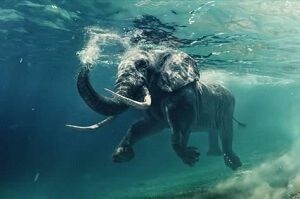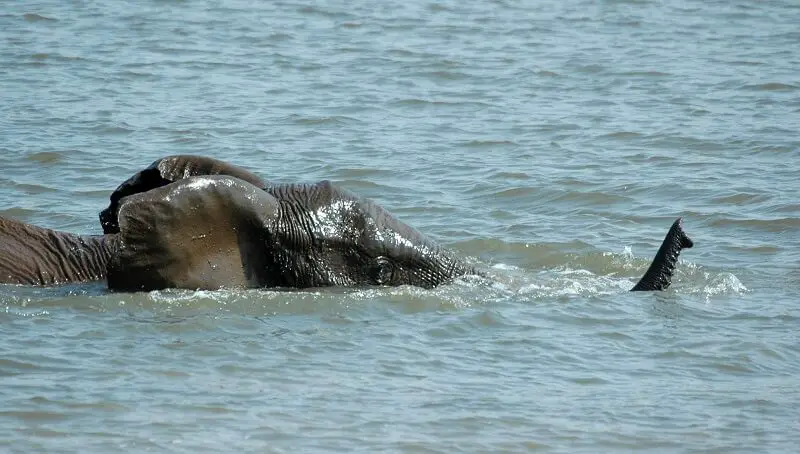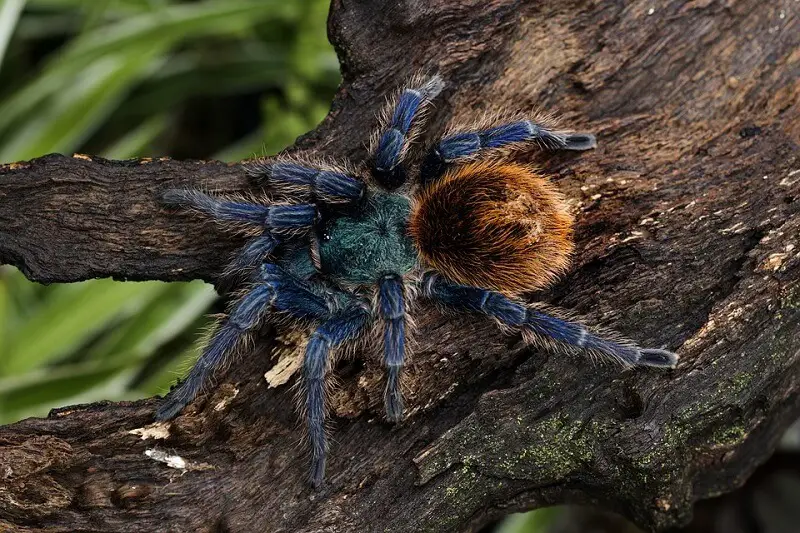The elephant is the largest land animal and has an amazing size, both for its body and its trunk. Interestingly, the trunk does not only work as a nose but also handles all sorts of other things.
Because of this feature, the elephant can catch everything and pick up any object, or carry food to its mouth, such as leaves, cabbage, grass, and fruit. When it wants to drink water, the elephant uses the trunk to release the water into its mouth. Another funny thing that the elephant does with its trunk is to play with the sand: It takes the sand inside its trunk and then lets it go, not only for fun but also to drive away the flies around it. The elephant is really smart.
You might also like my articles on whether cows, crabs, and deer can swim.
Elephants enter the water, not only for a brief splashing in a pond or to cross a river, but actually to swim right out into the open sea, sometimes traveling long distances, like they’re amphibious elephants!
The elephant is a huge and extremely intelligent animal. The mass of an African elephant can reach 7,5 tons, and the height at the shoulders is 4 m. Indian elephants are one-third smaller and reach a height of no more than 3 m. On average, the adult individual reaches about five tons. The heart of the elephant weighs an average of 20-30 kg.
An adult elephant can eat 200 kg of grass, shoots, and shrub leaves in a day. Imagine you have to feed an elephant for a year; you will need vegetation on an area of 5 square kilometers.
In a single day, an elephant drinks between 100 and 220 liters of water, while the trunk of this giant can take only 8,5 liters of liquid at a time.
The average life span of the elephant is 70 years. After 50 years, the elephant will not give birth anymore. Unfortunately, because of poaching, these animals pass away before they reach old age. Elephants live in herds where the role of the leader is upon an adult female. Usually, they all fall into this family related to each other, and if a member of the group passes away, the others suffer from the loss of the loved one. Interestingly, these good souls are capable of being happy and even laughing. At a meeting, they gently embrace themselves with their trunks.
How do elephants swim?
Elephants are excellent swimmers who love to stay in the water. It is also interesting that they bathe not only on the shore, but they also sink in deep water, where they have a good time.
It may be unclear to some people why elephants can swim because they are so big, that they supposedly have to drown. In fact, when they enter the water, they begin to touch it with their feet, creating powerful waves under the water that allow them to maneuver. Such movements cannot be compared to the panic of a drowning man; the feet of an animal move rhythmically and intentionally. Of course, the animal chooses fresh water for their bathing, and if they swim in the sea, they rarely sink, and only due to exhaustion.
Elephants use their trunks as a breathing tube underwater and have a unique lung structure among mammals that allows them to withstand pressure variations between the upper and the underwater.
Genetically they are close relatives of manatees and dugongs, animals that live mainly underwater.
How long can elephants swim?
Elephants are very good swimmers. They can swim up to 15 kilometers from shore, and doing this is not unusual for an elephant. They can’t keep swimming for too long a distance because they consume a lot of energy.
They were recorded to swim for up to six hours without touching the bottom of the water and travel up to 48 km through the water at speeds of up to 2,1 km/h.
They swim great, and there is a case, officially confirmed, when an elephant crossed a 70-kilometer-wide Strait.
Can baby elephants swim?
Usually, only one baby is born after a pregnancy that lasts 22 months. A newborn elephant is called a calf, weighs 70-160 pounds, and is about a meter tall. In its first two years, the baby is breastfed, but in the meantime learns to use its trunk and chew herbs and bushes.
A baby elephant doesn’t know how to swim from the beginning of its life; it will learn a few months after birth. In order to learn how to swim, their mothers will take them near water to get used to the movements while also keeping them out of deep waters.
If you didn’t see a baby elephant playing in the water yet, you should go to a zoo where they have one, because it’s a total delight and something that will surely cheer you up.
Do elephants like to swim?
Although the elephant rarely swims, it bathes with great pleasure!
That elephants like to play with water and this is not a novelty; interestingly, despite their size, they are good swimmers. Swimming is a skill required for crossing rivers and lakes when traveling in search of food. When they swim in deep waters, they keep their trunk on the surface to breathe.
Can elephants swim underwater?
 It is also known that elephants not only swim, but sometimes they sink to the bottom and are able to overcome long distances from coast to coast. Some saw the animal sail several kilometers and then continue its journey on land. In addition, they can dive deep while using their long trunks as a diving tube.
It is also known that elephants not only swim, but sometimes they sink to the bottom and are able to overcome long distances from coast to coast. Some saw the animal sail several kilometers and then continue its journey on land. In addition, they can dive deep while using their long trunks as a diving tube.
Elephants are very fond of bathing and spraying and are good swimmers. At the same time, when they swim in deep water, they hold their face above the water and their mouth underneath. In order to breathe, they keep their trunk above the water, like a swimmer holds a breathing tube.
So, they can also be good snorkelers. They often get tired and choose to swim almost fully underwater, only with their trunks above, breathing.
If there are no external factors, like currents, or alligators, it is almost impossible for it to drown. They also have the possibility to rest by floating.
Do Elephants drink water with their trunk?
The elephant’s trunk is a fusion of the nose and upper lip, elongated and specialized to become the most important and versatile appendix of the animal.
The trunk of an elephant is sensitive enough to lift a single strain of grass from the ground but strong enough to pull a tree out of the ground. The trunk is also used for drinking.
Elephants suck up to 8,5 liters of water at a time and then transfer it to their mouths. They also use their trunk to spray water on their bodies while bathing. In addition to this cold shower, animals splash mud, which dries and acts as sun protection.
During swimming, the trunk acts as a breathing tube. The elephant’s trunk is a very complex tool, and elephants don’t use it worse than we use our hands.
Now you know that elephants can swim and they also love water, so you can share this information with your friends.




